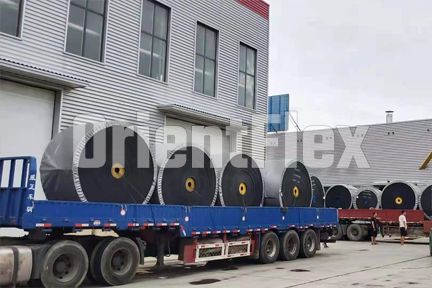- Email orientflex@orientrubber.com
- WhatsApp / Phone+86 180 3186 9514
Conveyor belt is a key component of the conveying system, and its safe and stable operation directly affects production operations. The deviation of the conveyor belt is the most common fault of the belt conveyor. If you are not careful, the conveyor belt will be worn on one side, the joint will be broken, and the belt will be torn. The timely and accurate treatment will ensure its safe and stable operation.
As an expert in rubber production from design, production, sales to service, Orientflex is pleased to assist you with the following:
During transportation and storage, the conveyor belt should be kept clean, avoid direct sunlight or rain and snow, avoid contact with acids, alkalis, oils, organic solvents and other substances, and be 1 meter away from the heating device. During storage, the product must be placed in rolls, not folded, and should be turned quarterly during the storage period. Doing so will cause the belt to bend, causing the belt to deviate on the conveyor.
To keep conveyor and drive belts off track, you can use crowned rollers. Crown means that the diameter of the roller or pulley is small at both ends, gradually increasing towards the middle, with a slightly curved surface. Making the pulleys crowned keeps the belt on track because the belt always deviates in the direction of the largest diameter during rotation.
Another way to keep the belt off track is to use integrated alignment guides and wearstrips. Conveyor or drive belts often move slightly from one side to the other, and a new conveyor or drive belt can never run perfectly straight. By using the guide rails, the lateral displacement distance of the conveyor belt or drive belt can be adjusted. The rails help align the belt or drive correctly, while the wearstrip edges prevent the belt or drive from slipping off the rollers.
If there is material on the part of the roller and the idler, the diameter of the place will increase, resulting in an increase in the tension of the conveyor belt at that place, resulting in deviation. Adhesive materials should be cleaned up in time.
If the conveyor belt always deviates to one side, a limit vertical roller can be installed on the frame on the deviation side; in this way, on the one hand, the conveyor belt can be forced to reset, and on the other hand, the vertical roller can reduce the pulling force of the conveyor belt on the deviation side, to move the conveyor belt to the other side.
Rails are especially useful on vertical conveyors where gravity can cause products to slip. If conveying heavy items and requiring support, rails help keep the belt on track and prevent products from slipping or jamming. One advantage of rails is that they wear out faster than belts. Because you don't have to replace your belts as often, you can extend service life and reduce operating costs.
Orientflex is present our customers with the highest quality products, fastest service, and extremely competitive pricing. Products sells in all province of domestic market, and exported to more than 60 countries and region such as Middle East, Europe, South America, Southeast Asia and Africa.
If you have any interest about our conveyor belt, please contact us.
You can contact or visit us in our office from Monday to Friday from 8:00 - 18:00





